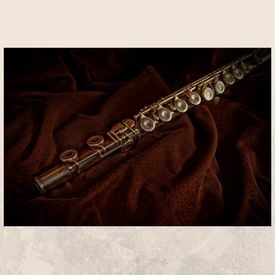Introduction to Playing Second Octave Sounds
Playing second octave sounds on the flute are generally learnt after the first octave notes. When learning the flute you play a range of pieces using notes in the first octave. For example , the following piece.
Have a listen to first octave sounds May The Road Ride To Meet You.
Then you go learn and play the second octave.
The first note you learn to play in the second octave is generally E.
So how do you achieve E
and the other Second Octave Notes?
To produce those second octave sounds you need to increase the speed of the air that you are blowing by making the size of your embouchure smaller.
Imagine a hose with water flowing out. If you squeeze the hose to make a smaller diameter where the water can flow out, what happens? Yes, the water comes out faster.
You need to do the same with your lips so that the air comes out faster.
How Do You Do This?
To get a smaller lip hole you move your jaw forward to direct the air more outwards and squeeze the sides of your lips.
Jaw Exercise to Feel the Jaw Moving Forward
1. Place your hand about 5 cm away from your lips such that when you blow straight across the air is in the middle of your palm.
2. Now blow onto your palm as if you were playing lower octave sounds.
The air should be felt below the middle of your palm.
3. Now move your jaw or lower lip forward and blow onto the palm of your hand so the air is felt higher than the middle of the palm.
The distance between the middle of the palm and the point at where you get the second octave sounds is the same distance as the distance between the middle of the palm and the point at which you produce the lower octave sounds.
If you felt the air on your hand above the middle then you are on the right track.
Feeling the Jaw and Lip Movement on the Flute
1. Play some first octave sounds on the flute.
2. Then move your jaw forward like you did in the above exercise and squeeze the sides of the lips together at the same time. This movement will direct the air higher on the far side of the flute embouchure hole.
3. You need to finger ( see fingering below ) second octave sounds starting from E2 and blow.
As you move up the octave from E2, then you will need to make the lips smaller. Producing E2, F2 are fairly similar. Then from G2 upwards gradually do more subtle movements forward with squeezing the lips to produce the sound.
Fingering
All the second octave notes from E2 to C#3 are fingered exactly the same as the first octave notes from E1 to C#2. All D’s and D#’s have different fingering throughout the flute register.
Now that you know what to do, it is a matter taking action with the three P’s.
PLAY PLAY PLAY
Playing Second Octave Sounds
Exercises
It is a good idea to play some exercises slowly to get the feel of your new notes.
Firstly play 2 note exercises, like D2 to E2, E2 to F2 etc. You can make it like a siren sound where you repeat the pairs of notes. D2 E2 D2 E2, E2 F2 E2 F2 etc.
Secondly you can play D to another second octave note as follows.
D to E; D to F; D to G; D to A
Thirdly, make up your own tunes using both first and second octave notes. Start off getting used to adding E2’s to first octave notes and then gradually add the other ones.
Pieces
Now play pieces with your new second octave notes starting with E.
You can make up your own tunes using both first and second octave notes. Start off getting used to adding E2’s to first octave notes and then gradually add the other ones.
Then you can read music and gradually move on to higher notes as each second octave sound gets easier to produce.
To make the new note E easier to play you can pull out the note before the E2 in the piece and do siren sounds with that note and E2. And you can pull out the note after the E2 and do siren sounds with that note and E2. And then this makes it relevant.
Here is one tune from the book.
Just remember to keep on
PLAYING
on different days of the week
and
you will be racing towards the third octave sounds in no time
and playing many of you favourite tunes.
If you have any questions related to playing second octave sounds on the flute contact me here.
